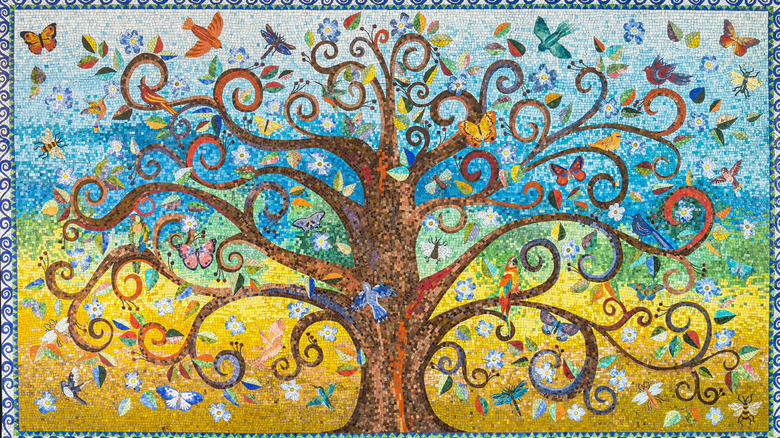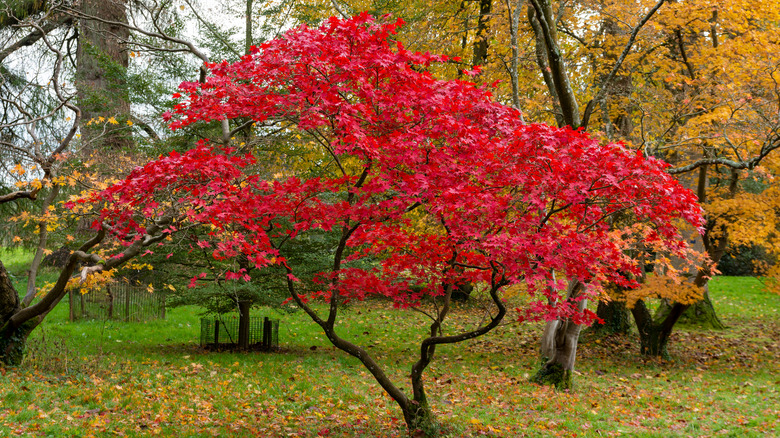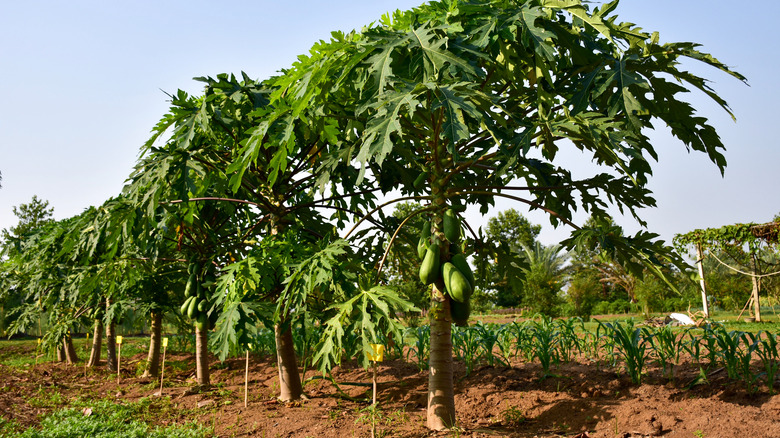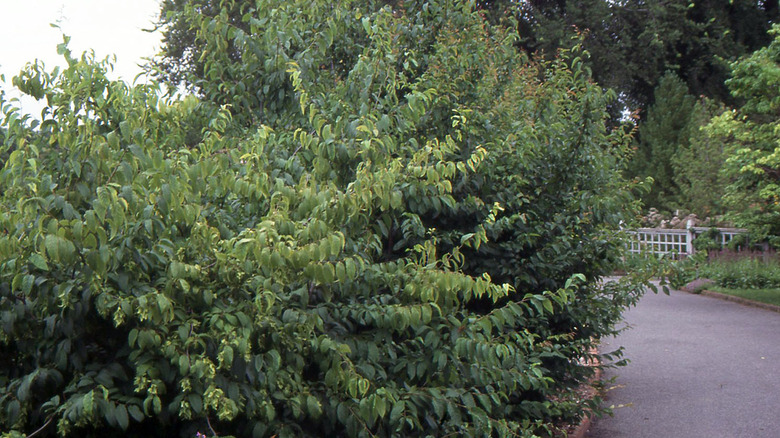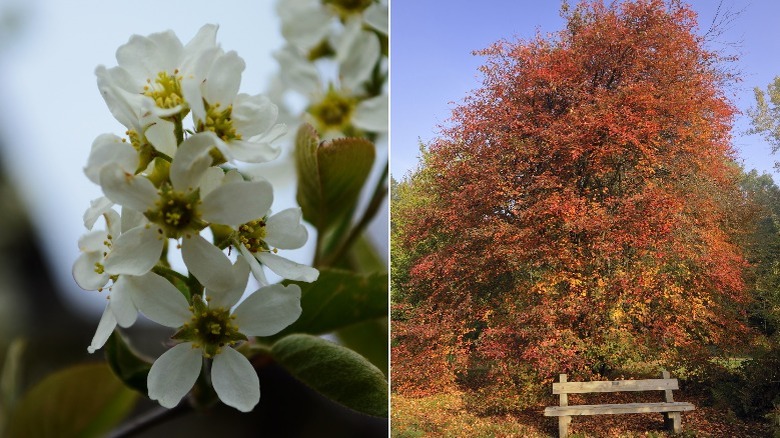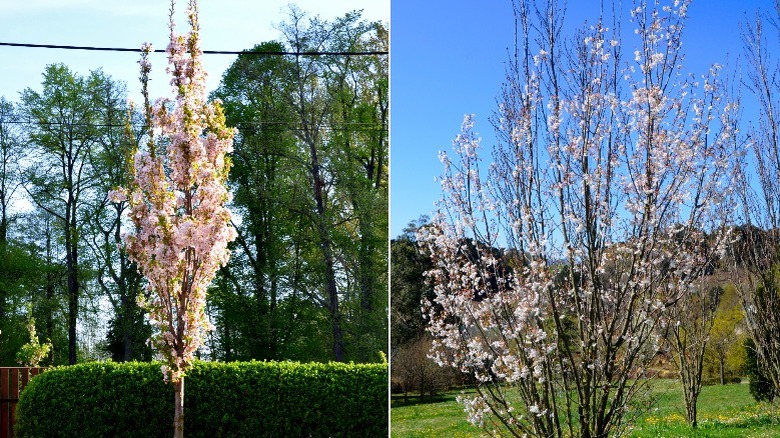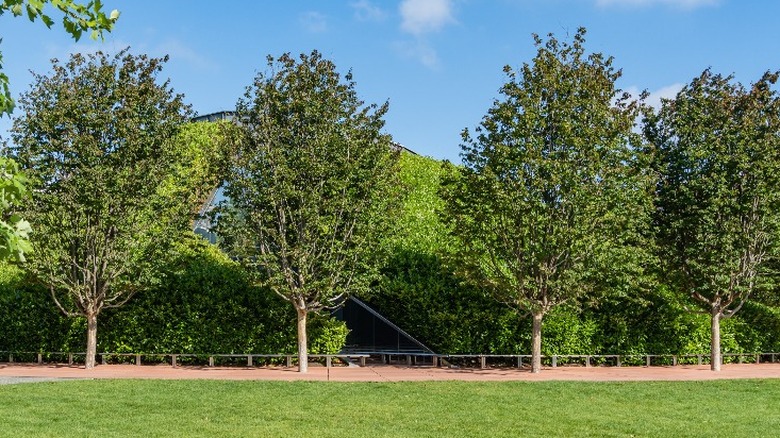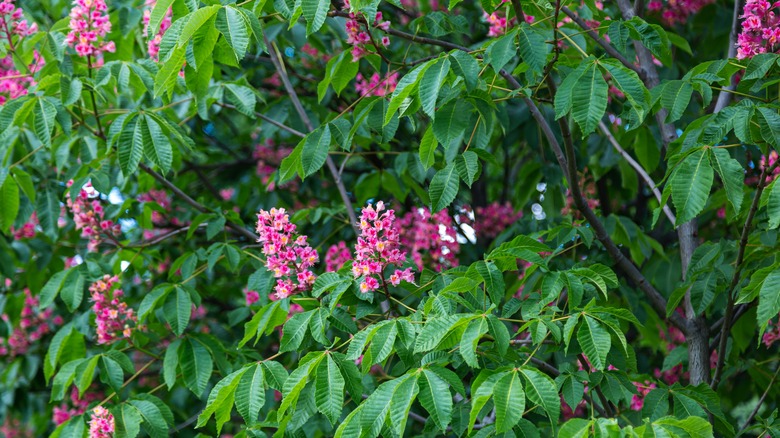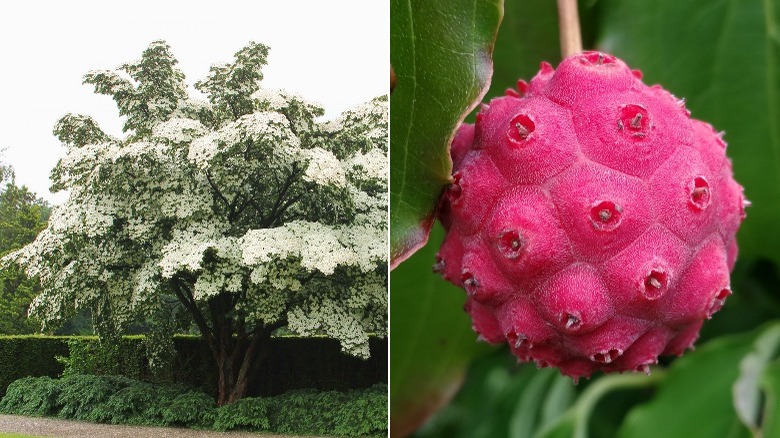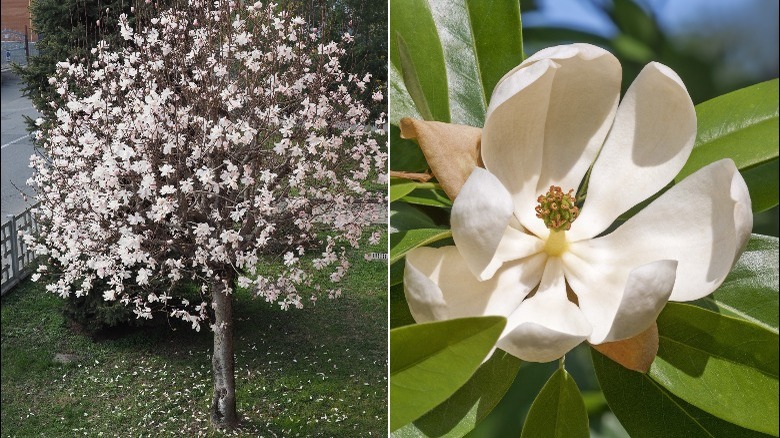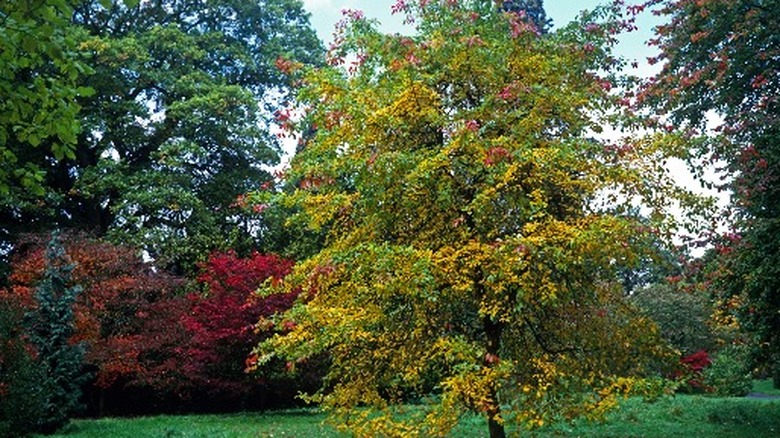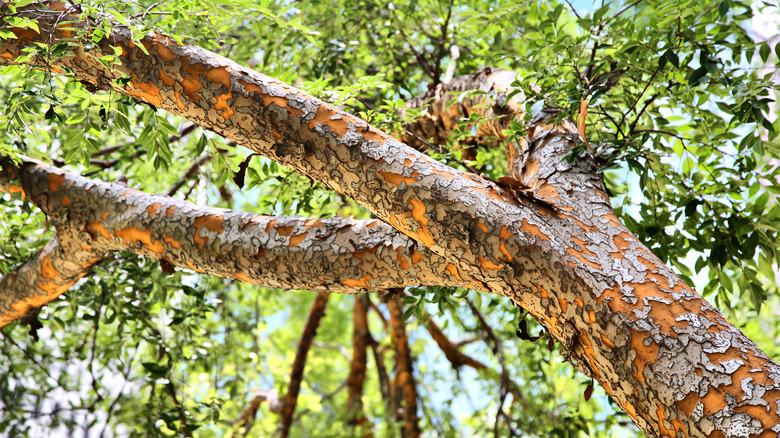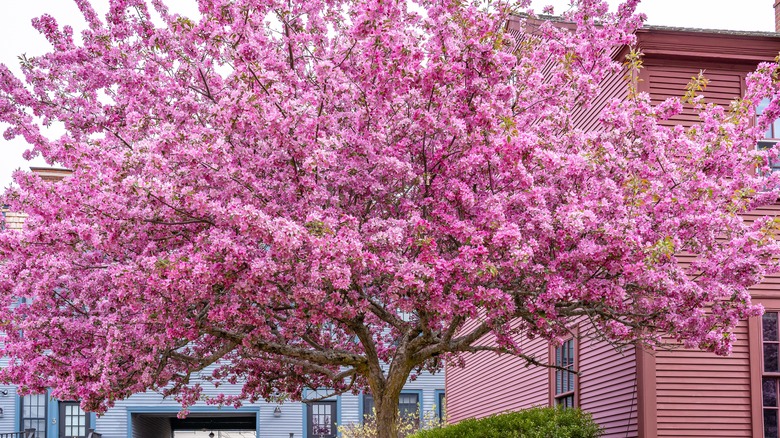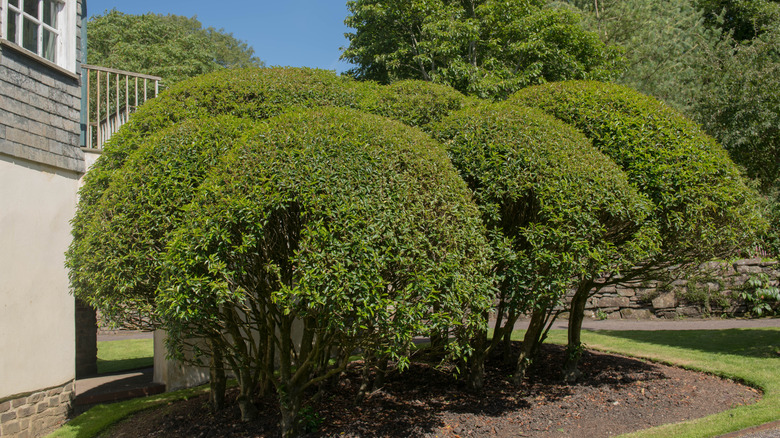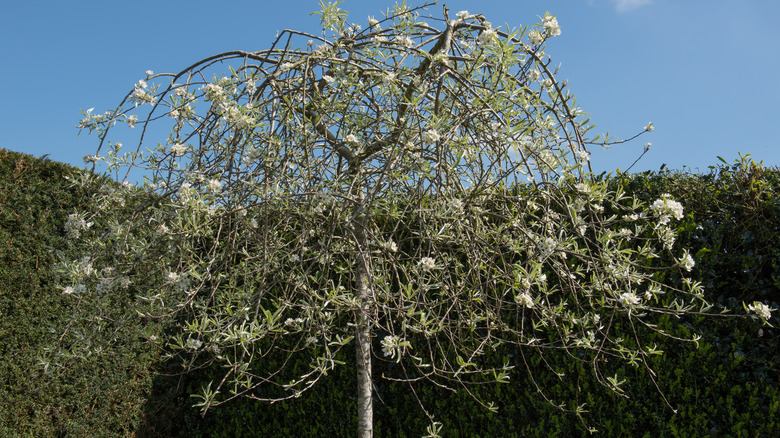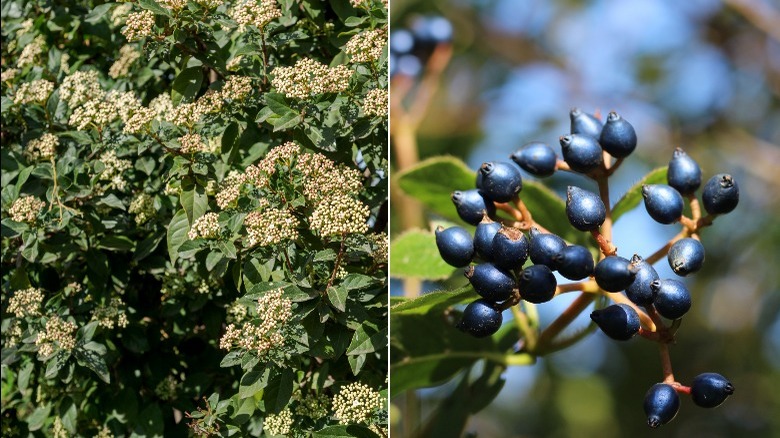15 Small Trees That Grow In The Shade
If you love foliage and greenery but only have a shady garden, or maybe you have a shady part of your garden that's looking a bit bare, there are plenty of trees that grow well in the shade. Gardening etc had some tips for working out the level of shade your garden has. You might have deep shade, which is a full and intense shade that gets less than 2 hours of sun per day. Or, it may be moderate shade and experience dappled sunlight for two or three hours.
There are plenty of trees that thrive well in all types of shade, but to make sure they get the best opportunity to grow, you need to follow a few simple rules. Watering them more frequently than plants and trees that get lots of sunlight will help, as will a thick top layer of compost to help keep in that extra moisture. Keep in mind that any areas underneath small trees will be even more shaded, so any flowers planted there will have to be shade friendly too.
Japanese Maple
A small deciduous tree, Japanese maple (acer palmatum) or 'red wood' has beautiful green leaves during springtime and summer and pinky yellow leaves in autumn. Shoot comments that it stands out from other trees as it has bright-red foliage. It copes well in full sun as well as shade and reaches a height of 6 meters. It does best in loamy, well-drained, moist soil and its preferred USDA zones are 9 to 6.
Provender Nurseries added that pruning should be kept to a minimum and preferably pruning during young life should be done purely for shaping where necessary.
Pawpaw
According to Southern Living, the pawpaw (asimina triloba), is a very easy tree to grow and it yields fruit that is custardy and delicious. It has dark green leafy foliage and enjoys a temperate climate. They have yellow leaves in autumn and deep red wine-colored flowers in springtime.
They can grow up to 30 meters if grown in full sun, but when placed in a shady spot they are much smaller in height. They appreciate moist, fertile, well-draining soil, and the USDA growing zones are 5 to 8.
American Hornbeam
The American hornbeam (carpinus caroliniana) is a small, leafy tree that sometimes has a blue-grey hue to both its bark and leaves, which gave it its other term, the blue beech, says Van Den Berk. They go on to explain how it grows beautiful, trailing catkins in the spring and attractive red-orange leaves in autumn. It likes loamy, moist, fertile soil and grows to a height of 6 meters when grown in a shaded area. The USDA growing zones are 3 to 9.
Allegheny Serviceberry
The Morton Arboretum describes this tree, the Allegheny serviceberry (amelanchier laevis) as an understory tree that reaches a height of 9 meters and which prefers partial or moderate shade. It grows small, purple, edible berries in late summer and has clusters of fragrant, white flowers in spring. Its orange-red leaves in autumn mean this tree has something for nearly all seasons. It prefers alkaline, well-draining, moist soil. USDA zones are 3 through 8.
Flagpole Cherry
Most people would agree that a carpet of cherry blossoms is a beautiful right of passage for any garden during spring. However, If you only have a small, shady area, then the flagpole cherry (prunus serrulata,) with a width of just 60 to 80 centimeters, can do just that for your garden, states Fine Gardening.
It is a narrow, slender tree that grows to a height of around 6 meters and could slot into a small area very well. It likes well-drained, loamy but moist soil and the USDA zones are 5 to 8.
Persian Ironwood
The Persian ironwood (parrotia persica) is known for its four-season interest according to Fine Gardening. During spring and summer, it showcases ruby red leaves. Autumn brings rich, purple-orange hues and in the winter the gray bark is covered in plenty of bright red flowers. It is a narrow, columnar tree that likes partial, dappled shade and grows to a height of 6 meters. It prefers moist and well-drained soil in USDA zones 5 to 8.
Red Buckeye
Also known as the red horse chestnut, red buckeye (aesculus pavia) has dark green shiny leaves and, as RHS states, it grows to approximately 5 meters in height and enjoys partial, moderate shade. It should be planted in well-drained but moist soil of an acidic, alkaline, or neutral nature.
It can be lightly pruned by removing damaged or unwanted shoots. It has pink flowers and bushy leaves in summer, and brown and green inedible berries in autumn. The USDA zones are 5 to 9.
Kousa Dogwood
The kousa dogwood (cornus kousa) is a small bushy tree that reaches heights of 7 meters. During spring it has green foliage, summer brings clusters of cream flowers, followed by pink edible berries that resemble strawberries or raspberries, and the leaves turn a rich reddish-purple during autumn, says RHS.
It likes partial shade and grows best in loamy, sandy, moist but well-drained soil that can be acidic, alkaline, or neutral in its pH levels. USDA zones for this deciduous tree are 5 through 8.
Sweetbay Magnolia
Sweetbay magnolia (magnolia virginiana) is a tree that when grown in cooler, shady areas stays below 9 meters in height, states Gardening know how. Its cream-colored flowers have a fresh lemon scent and will not grow in dry soil, but prefers wet, slightly acidic soil.
The USDA zones are 5 through 10, but when grown in zone 5, extra care needs to be taken during very cold winters. Gardening Know How prompts to insulate the tree by placing plenty of organic mulch on top of the soil and be sure to keep the soil underneath moist.
Black Gum
The black gum tree (nyssa sylvatica,) also known as tupelo, is a deciduous tree with glossy, green, oval foliage that becomes reddish-purple in autumn. It has small, round, blue berries that are appealing to birds commented Deepdale.
It is a symmetrical tree, that does well in wet and wild spaces. While it has the ability to grow in water, it prefers fertile, moist soil and partial shade. It grows to around 5 meters in height and the USDA zones are 4 to 9.
Lacebark Elm
Known for its unusual bark with a lacy appearance, lacebark elm (ulmus parvifolia) is a small, deciduous tree that grows to heights of 8 to 15 meters. It prefers partial shade and moist, well-drained soil. The Morton Arboretum says the leaves are dark green in summer and yellow, or a reddish-purple in the autumn time. Flowers come in late summer as opposed to spring and bears small oval seeds equipped with wings for ease of dispersion via the wind. The Morton Arboretum advises not to prune between April and October. The USDA zones are 5 to 9.
Eastern Redbud
This is a small deciduous tree that also goes by the name eastern redbud (cercis canadensis) or ace of hearts. Gardenia explains that this tree has a very dramatic and beautiful blossom display during the springtime when it is covered with clusters of small hot pink flowers that last up to 3 weeks, giving any garden a cheerful look.
It likes moist, well-drained, fertile soil and partial shade. Gardenia also informs that this tree should not be transplanted and should be left alone to grow. The USDA zones for this tree are 5 to 9 and it grows up just over 3 meters.
Portuguese Laurel
This particular tree, the Portuguese laurel (prunus lusitanica,) grows to a height of 12 meters and prefers partial shade. According to Gardening etc, this is one of the best trees to grow in the shade, and due to its heavily and densely packed leaves, it is also ideal for those seeking some privacy.
It grows best in moist, well-drained soil, and during the months of May and April it has a flurry of small creamy flowers that become red cherries. In Autumn the berries turn purple, and although not edible by humans; wildlife, especially birds, love them. USDA zones are 4 through 9
Weeping Silver Pear
Known as the weeping silver pear (pyrus salicifolia,) this tree is happy to be planted under large evergreens and tolerates partial shade, says Gardenia Organic. Reaching a final height of 7 meters, it has long, elegant, hanging branches with velvet-like silver-colored leaves and white flowers that grow in April. It likes all soil types as long as they are both moist and well-draining. GflOutdoors suggests pruning in winter and making sure the branches are trimmed to at least 1-foot above the ground. The recommended USDA zones are 4 to 7.
Arrowwood Eskimo
This tree is known by the name arrowwood Eskimo (viburnum tinus.) It is a dwarf tree that will brighten any shaded area in your garden, claims Gardenia Organic. It starts off with beautiful pink buds in the latter part of winter which transform into white flowers in the new year. Eventually, the viburnum tinus will develop blueish, purple berries which will be edible to birds. It grows to around 1 1/2 meters and prefers loamy, fertile, well-drained soil in full or partial shade. The USDA zones are 2 through 9.
